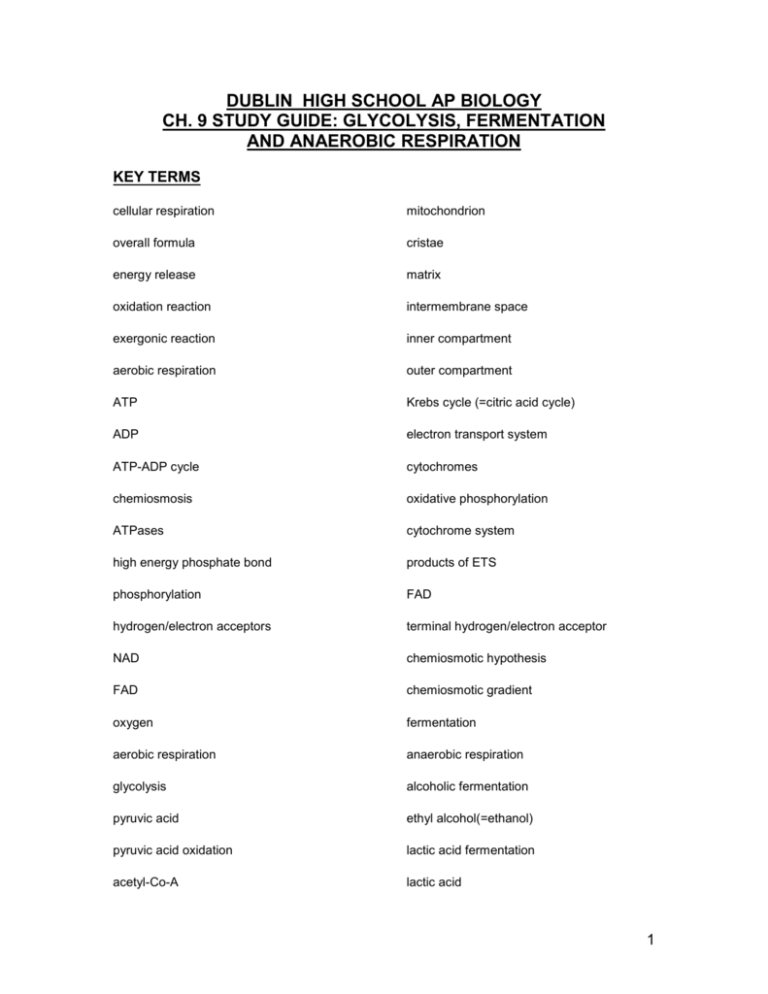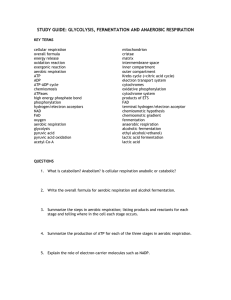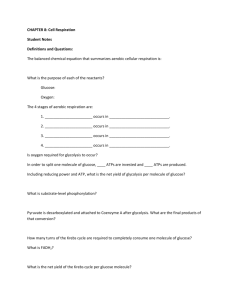study guide: glycolysis, fermentation and anaerobic respiration
advertisement

DUBLIN HIGH SCHOOL AP BIOLOGY CH. 9 STUDY GUIDE: GLYCOLYSIS, FERMENTATION AND ANAEROBIC RESPIRATION KEY TERMS cellular respiration mitochondrion overall formula cristae energy release matrix oxidation reaction intermembrane space exergonic reaction inner compartment aerobic respiration outer compartment ATP Krebs cycle (=citric acid cycle) ADP electron transport system ATP-ADP cycle cytochromes chemiosmosis oxidative phosphorylation ATPases cytochrome system high energy phosphate bond products of ETS phosphorylation FAD hydrogen/electron acceptors terminal hydrogen/electron acceptor NAD chemiosmotic hypothesis FAD chemiosmotic gradient oxygen fermentation aerobic respiration anaerobic respiration glycolysis alcoholic fermentation pyruvic acid ethyl alcohol(=ethanol) pyruvic acid oxidation lactic acid fermentation acetyl-Co-A lactic acid 1 WORD ROOTS aero - = air (aerobic: chemical reaction using oxygen) an - = not (anaerobic: chemical reaction not using oxygen) chemi - = chemical (chemiosmosis: the production of ATP using the enrgy of hydrogen ion gradients across membranes to phophorylate ADP) glyco - = sweet; - lysis = split (glycolysis: the splitting of glucose into pyruvate) QUESTIONS 1. What is catabolism? Anabolism? Is cellular respiration anabolic or catabolic? 2. Write the overall formula for aerobic respiration and alcohol fermentation. 3. Summarize the steps in aerobic respiration; listing products and reactants for each stage and telling where in the cell each stage occurs. 4. Summarize the production of ATP for each of the three stages in aerobic respiration. 5. Explain the role of electron-carrier molecules such as NADP. 6. Explain how the production of ATP (oxidative phosphorylation) occurs according to the chemiosmotic hypothesis. Use a diagram of a mitochondrion in your explanation. 7. Explain the process of fermentation. 2 8. Diagram a mitochondrion, show where the Krebs cycle and ETS are found. 9. Outline Mitchell's chemiosmotic hypothesis. 10. What arguments would you use to justify calling the mitochondria the "powerhouse" of the cell? 11. What is the specific role of oxygen in an aerobic cell? 12. When and where does anaerobic respiration occur in humans? What is the end product of this anaerobic respiration? Sample Essay Questions 1. Describe the similarities and differences between the biochemical pathways of aerobic respiration and photosynthesis in eukaryotic cells. Include in your discussion the major reactions, the end products and energy transfers. (1982 AP Exam question) 2. Explain how the molecular reactions of cellular respiration transform the chemical bond energy of krebs cycle substrates into the more readily available bond energy of ATP. Include in your discussion the structure of the mitochondrion and show how it is important to the reactions of the Krebs cycle and the electron transport chain. (1977 AP Exam question) 3








